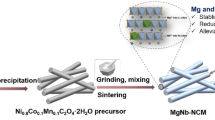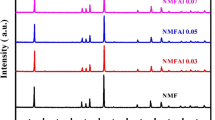Abstract
Cation-disordered rocksalt (DRX) oxides show promise as lithium-ion battery cathodes due to their high theoretical capacity derived from anionic redox. However, the challenges of poor anionic redox reversibility, causing oxygen loss and voltage hysteresis, lead to rapid capacity decay. This study employs a dual-functional urea treatment on Li1.2Ti0.4Mn0.4O2 DRX cathodes, generating oxygen vacancies in the subsurface and a protective carbon nitride layer on the surface through interface reactions. Characterization via X-ray diffraction, scanning electron microscopy, transmission electron microscopy, and X-ray photoelectron spectroscopy confirms these alterations. The presence of oxygen vacancies reduces the average Mn valence, increasing the capacity contributed by Mn and enhancing the reversibility of anionic oxygen redox, thus curbing oxygen loss. Additionally, the carbon nitride layer curtails the parasitic reaction between active oxygen species and the electrolyte. Urea-treated Li1.2Ti0.4Mn0.4O2 exhibits enhanced electrochemical performance, retaining a higher capacity (151 mAh⋅g−1, 80.3% of capacity retention) after 50 cycles compared to neat Li1.2Ti0.4Mn0.4O2 (117 mAh⋅g−1, 64.6% retention). Furthermore, the treatment improves lithium-ion diffusion and rate capability. This dual-functional urea approach presents a promising strategy for enhancing DRX cathode materials and advancing high-performance lithium-ion batteries.
Graphical Abstract









Similar content being viewed by others
References
Zhang H, Gao X, Cai Q, Zhang X, Tian Y, Jia M, Xie W, Du Y, Yan X (2023) Recent progress and perspectives on cation disordered rock-salt material for advanced li-ion batteries. J Mater Chem A. https://doi.org/10.1039/D3TA00852E
Lee J, Urban A, Li X, Su D, Hautier G, Ceder G (2014) Unlocking the potential of cation-disordered oxides for rechargeable lithium batteries. Science 343:519–522. https://doi.org/10.1126/science.1246432
Xu J, Patil S, Koirala KP, Chen W, Campos-Mata A, Wang C, Roy S, Nanda J, Ajayan PM (2023) Enhancing the electrode gravimetric capacity of Li1.2Mn0.4Ti0.4O2 cathode using interfacial carbon deposition and carbon nanotube-mediated electrical percolation. ACS Appl Mater Interfaces 15:31711–31719. https://doi.org/10.1021/acsami.3c04805
Qian J, Ha Y, Koirala KP, Huang D, Huang Z, Battaglia VS, Wang C, Yang W, Tong W (2023) Toward stable cycling of a cost-effective cation-disordered rocksalt cathode via fluorination. Adv Funct Mater 33:2205972. https://doi.org/10.1002/adfm.202205972
Clement RJ, Lun Z, Ceder G (2020) Cation-disordered rocksalt transition metal oxides and oxyfluorides for high energy lithium-ion cathodes. Energy Environ Sci 13:345–373. https://doi.org/10.1039/c9ee02803j
Lun Z, Ouyang B, Cai Z, Clement R, Kwon D-H, Huang J, Papp JK, Balasubramanian M, Tian Y, McCloskey BD, Ji H, Kim H, Kitchaev DA, Ceder G (2020) Design principles for high-capacity Mn-based cation-disordered rocksalt cathodes. Chem 6:153–168. https://doi.org/10.1016/j.chempr.2019.10.001
Zhuo Z, Dai K, Qiao R, Wang R, Wu J, Liu Y, Peng J, Chen L, Chuang Y, Pan F, Shen Z, Liu G, Li H, Devereaux T, Yang W (2021) Cycling mechanism of Li2MnO3: Li-CO2 batteries and commonality on oxygen redox in cathode materials. Joule 5:975–997. https://doi.org/10.1016/j.joule.2021.02.004
Yabuuchi N, Takeuchi M, Komaba S, Ichikawa S, Ozaki T, Inamasu T (2016) Synthesis and electrochemical properties of Li1.3Nb0.3V0.4O2 as a positive electrode material for rechargeable lithium batteries. Chem Commun 52:2051–2054. https://doi.org/10.1039/c5cc08034g
Lee J, Seo D-H, Balasubramanian M, Twu N, Li X, Ceder G (2015) A new class of high capacity cation-disordered oxides for rechargeable lithium batteries: Li-Ni-Ti-Mo oxides. Energy Environ Sci 8:3255–3265. https://doi.org/10.1039/C5EE02329G
Cambaz MA, Vinayan BP, Euchner H, Pervez SA, Gesswein H, Braun T, Gross A, Fichtner M (2019) Design and tuning of the electrochemical properties of vanadium based cation-disordered rock-salt oxide positive electrode material for lithium-ion batteries. ACS Appl Mater Interfaces 11:39848–39858. https://doi.org/10.1021/acsami.9b12566
Chen R, Ren S, Knapp M, Wang D, Witter R, Fichtner M, Hahn H (2015) Disordered lithium-rich oxyfluoride as a stable host for enhanced Li+ intercalation storage. Adv Energy Mater 5:1401814. https://doi.org/10.1002/aenm.201401814
Lee J, Papp JK, Clément RJ, Sallis S, Kwon D-H, Shi T, Yang W, McCloskey BD, Ceder G (2017) Mitigating oxygen loss to improve the cycling performance of high capacity cation-disordered cathode materials. Nat Commun 8:981. https://doi.org/10.1038/s41467-017-01115-0
Zhou K, Zheng S, Ren F, Wu J, Liu H, Luo M, Liu X, Xiang Y, Zhang C, Yang W, He L, Yang Y (2020) Fluorination effect for stabilizing cationic and anionic redox activities in cation-disordered cathode materials. Energy Stor Mater 32:234–243. https://doi.org/10.1016/j.ensm.2020.07.012
Ouyang B, Artrith N, Lun Z, Jadidi Z, Kitchaev DA, Ji H, Urban A, Ceder G (2020) Effect of fluorination on lithium transport and short-range order in disordered-rocksalt-type lithium-ion battery cathodes. Adv Energy Mater 10:1903240. https://doi.org/10.1002/aenm.201903240
Zhou K, Zheng S, Liu H, Zhang C, Gao H, Luo M, Xu N, Xiang Y, Liu X, Zhong G, Yang Y (2019) Elucidating and mitigating the degradation of cationic-anionic redox processes in Li1.2Mn0.4Ti0.4O2 cation-disordered cathode materials. ACS Appl Mater Interfaces 11:45674–45682. https://doi.org/10.1021/acsami.9b16011
Huang B, Wang R, Gong Y, He B, Wang H (2019) Enhanced cycling stability of cation disordered rock-salt Li1.2Ti0.4Mn0.4O2 material by surface modification with Al2O3. Front Chem 7:1–7. https://doi.org/10.3389/fchem.2019.00107
Ding X, Luo D, Cui J, Xie H, Ren Q, Lin Z (2020) An ultra-long-life lithium-rich Li1.2Mn0.6Ni0.2O2 cathode by three-in-one surface modification for lithium-ion batteries. Angew Chem Int Ed 59:7778–7782. https://doi.org/10.1002/anie.202000628
Ma Q, Chen Z, Zhong S, Meng J, Lai F, Li Z, Cheng C, Zhang L, Liu T (2021) Na-substitution induced oxygen vacancy achieving high transition metal capacity in commercial Li-rich cathode. Nano Energy 81:105622. https://doi.org/10.1016/j.nanoen.2020.105622
Zhang R, Wang Y, Fan J, Zheng M, Dong Q (2023) The strategy of surface oxygen vacancy stabilization for high-performance lithium-rich cathode materials. J Electrochem Soc 170:030517. https://doi.org/10.1149/1945-7111/acbf7d
Qiu B, Zhang M, Wu L, Wang J, Xia Y, Qian D, Liu H, Hy S, Chen Y, An K, Zhu Y, Liu Z, Meng YS (2016) Gas-solid interfacial modification of oxygen activity in layered oxide cathodes for lithium-ion batteries. Nat Commun 7:12108. https://doi.org/10.1038/ncomms12108
Pei Y, Chen Q, Wang M, Li B, Wang P, Henkelman G, Zhen L, Cao G, Xu C-Y (2020) Reviving reversible anion redox in 3d-transition-metal Li rich oxides by introducing surface defects. Nano Energy 71:104644. https://doi.org/10.1016/j.nanoen.2020.104644
Zhou K, Zhang C, Li Y, Liu X, Liu J, Lun Z, Yang Y (2023) A critical evaluation of interfacial stability in Li-excess cation-disordered rock-salt oxide cathode. Chem Eng J 464:142709. https://doi.org/10.1016/j.cej.2023.142709
Sun Z, Wang H, Wu Z, Wang L (2018) G-C3N4 based composite photocatalysts for photocatalytic CO2 reduction. Catal Today 300:160–172. https://doi.org/10.1016/j.cattod.2017.05.033
Lin T, Schulli TU, Hu Y, Zhu X, Gu Q, Luo B, Cowie B, Wang L (2020) Faster activation and slower capacity/voltage fading: a bifunctional urea treatment on lithium-rich cathode materials. Adv Funct Mater 30:1909192. https://doi.org/10.1002/adfm.201909192
Li Z, Ren Y, Mo L, Liu C, Hsu K, Ding Y, Zhang X, Li X, Hu L, Ji D, Cao G (2020) Impacts of oxygen vacancies on zinc ion intercalation in VO2. ACS Nano 14:5581–5589. https://doi.org/10.1021/acsnano.9b09963
Shirazi Moghadam Y, Dinda S, Melinte G, Fichtner M (2022) Structural and electrochemical insights from the fluorination of disordered Mn-based rock salt cathode materials. Chem Mater 34(5):2268–2281. https://doi.org/10.1021/acs.chemmater.1c04059
Lu X, Xu K, Chen P, Jia K, Liu S, Wu C (2014) Facile one step method realizing scalable production of g-C3N4 nanosheets and study of their photocatalytic H2 evolution activity. J Mater Chem A 2:18924–18928. https://doi.org/10.1039/C4TA04487H
Zhu B, Xia P, Li Y, Ho W, Yu J (2017) Fabrication and photocatalytic activity enhanced mechanism of direct z-scheme g-C3N4/Ag2WO4 photocatalyst. Appl Surf Sci 391:175–183. https://doi.org/10.1016/j.apsusc.2016.07.104
Wu B, Yang X, Jiang X, Zhang Y, Shu H, Gao P, Liu L, Wang X (2018) Synchronous tailoring surface structure and chemical composition of Li-rich-layered oxide for high-energy lithium-ion batteries. Adv Funct Mater 28:1803392. https://doi.org/10.1002/adfm.201803392
Fang G, Zhu C, Chen M, Zhou J, Tang B, Cao X, Zheng X, Pan A, Liang S (2019) Suppressing manganese dissolution in potassium manganate with rich oxygen defects engaged high-energy-density and durable aqueous zinc-ion battery. Adv Funct Mater 29:1808375. https://doi.org/10.1002/adfm.201808375
Wang X, Pan Z, Chu X, Huang K, Cong Y, Cao R, Sarangi R, Li L, Li G, Feng S (2019) Atomic-scale insights into surface lattice oxygen activation at the spinel/perovskite interface of Co3O4/La0.3Sr0.7CoO3. Angew Chem Int Ed 58:11720–11725. https://doi.org/10.1002/anie.201905543
Tang W, Zhou G, Hu C, Li A, Chen Z, Yang Z, Su J, Zhang W (2023) Regulating the anion redox and suppressing the structural distortion of cation-disordered rock-salt cathode materials to improve cycling durability through chlorine substitution. ACS Appl Mater Interfaces 15:17938–14946. https://doi.org/10.1021/acsami.3c01280
Galakhov VR, Demeter M, Bartkowski S, Neumann M, Ovechkina NA, Kurmaev EZ, Lobachevskaya NI, Mukovskii YM, Mitchell J, Ederer DL (2002) Mn 3s exchange splitting in mixed-valence manganites. Phys Rev B 65:113102. https://doi.org/10.1103/PhysRevB.65.113102
Shirazi Moghadam Y, El Kharbachi A, Melinte G, Diemant T, Fichtner M (2022) Bulk and surface stabilization process of metastable Li-rich disordered rocksalt oxyfluorides as efficient cathode materials. J Electrochem Soc 169:120514. https://doi.org/10.1149/1945-7111/acaa62
He YY, Wang S, Zhang HY, Chen X, Li J, Xu HY, Zhang YH, Hu KH, Lv GP, Meng Y, Xiang W (2022) Identifying the effect of fluorination on cation and anion redox activity in Mn-based cation-disordered cathode. J Colloid Interface Sci 607:1333–1342. https://doi.org/10.1016/j.jcis.2021.09.101
Chen D, Kan WH, Chen G (2019) Understanding performance degradation in cation-disordered rock-salt oxide cathodes. Adv Energy Mater 9:1901255. https://doi.org/10.1002/aenm.201901255
Kan WH, Chen D, Papp JK, Shukla AK, Huq A, Brown CM, McCloskey BD, Chen G (2018) Unravelling solid-state redox chemistry in Li1.3Nb0.3Mn0.4O2 single-crystal cathode material. Chem Mater 30:1655–1666. https://doi.org/10.1021/acs.chemmater.7b05036
Chen Z, Wang S, Dai Y, Liang Y, Xin C, Jin S, Zhang C, Wang Q (2022) Ultra-high capacity of li1.6-xMn0.4TixO2 as a cathode material. J Alloys Compd 923:166356. https://doi.org/10.1016/j.jallcom.2022.166356
Geng F, Hu B, Li C, Zhao C, Lafon O, Trebosc J, Amoureux J-P, Shen M, Hu B (2020) Anionic redox reactions and structural degradation in a cation-disordered rock-salt Li1.2Ti0.4Mn0.4O2 cathode material revealed by solid-state MNR and EPR. J Mater Chem A 8:16515–16526. https://doi.org/10.1039/d0ta03358h
Lee KT, Jeong S, Cho J (2013) Roles of surface chemistry on safety and electrochemistry in lithium ion batteries. Acc Chem Res 46:1161–1170. https://doi.org/10.1021/ar200224h
Tang W, Li A, Zhou G, Chen Z, Yang Z, Su J, Zhang W (2022) Structural stabilization of cation-disordered rock-salt cathode materials: coupling between a high-ratio inactive Ti4+ cation and a Mn2+/Mn4+ two-electron redox pair. ACS Appl Mater Interfaces 14:38865–38874. https://doi.org/10.1021/acsami.2c10652
Chung H, Lebens-Higgins Z, Sayahpour B, Mejia C, Kamm GE, Li YX, Huang R, Piper LFJ, Chapman KW, Doux JM, Meng YS (2021) Experimental considerations to study Li-excess disordered rock salt cathode materials. J Mater Chem A 9:1720–1732. https://doi.org/10.1039/d0ta07836k
Brinkmann J-P, Ehteshami-Flammer N, Luo M, Leissing M, Roeser S, Nowak S, Yang Y, Winter M, Li J (2021) Compatibility of various electrolytes with cation disordered rocksalt cathodes in lithium ion batteries. ACS Appl Mater Interfaces 4:10909–10920. https://doi.org/10.1021/acsaem.1c01879
Jiang G, Hu Z, Xiong J, Zhu X, Yuan S (2018) Enhanced performance of LiFePO4 originating from the synergistic effect of graphene modification and carbon coating. J Alloys Compd 767:528–537. https://doi.org/10.1016/j.jallcom.2018.07.078
Guan P, Min J, Chen F, Zhang S, Zhu Y, Liu C, Hu Y, Wan T, Li M, Liu Y, Su D, Hart J, Li Z, Chu D (2023) Dual-modification of Ni-rich cathode materials through strontium titanate coating and thermal treatment. J Colloid Interf Sci 652:1184–1194. https://doi.org/10.1016/j.jcis.2023.08.101
Funding
This work was supported by grants from the Hubei Province Technology Innovation Project (2018AAA056), an Opening Fund of The Key Laboratory of Material Chemistry for Energy Conversion and Storage (HUST).
Author information
Authors and Affiliations
Contributions
Conceptualization, data curation, formal analysis, writing—original draft: Minyi Su; methodology, data curation, investigation: Yu Yan, Yining Sun. Investigation: Haiying Xie; conceptualization: Yaming Cheng; validation, supervision: Jian Xiong. Conceptualization, writing—review, and editing, supervision, validation: Guodong Jiang.
Corresponding author
Ethics declarations
Conflict of interest
The authors declare no competing interests.
Additional information
Publisher's Note
Springer Nature remains neutral with regard to jurisdictional claims in published maps and institutional affiliations.
Rights and permissions
Springer Nature or its licensor (e.g. a society or other partner) holds exclusive rights to this article under a publishing agreement with the author(s) or other rightsholder(s); author self-archiving of the accepted manuscript version of this article is solely governed by the terms of such publishing agreement and applicable law.
About this article
Cite this article
Su, M., Yan, Y., Sun, Y. et al. Dual-functional urea induced interface reaction enables the improved cycling stability of cation-disordered Li1.2Ti0.4Mn0.4O2 cathode. J Solid State Electrochem (2024). https://doi.org/10.1007/s10008-024-05831-8
Received:
Revised:
Accepted:
Published:
DOI: https://doi.org/10.1007/s10008-024-05831-8




